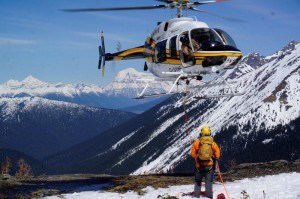
Parks Canada recently welcomed two new rescue helicopter pilots to its emergency response team.
Aaron Harris and Ken Lancour both earned their Class D rescue licence, allowing them to perform long line rescue missions in mountain national parks. Both men work for Yellowhead Helicopters, which works collaboratively with Parks Canada as needed.
“The Class D rescue allows you to carry a person on a long line externally from a helicopter,” explained Lancour, who has flown helicopters since 2002.
Before pilots can do a Class D rescue in a national park they must first pass a Parks certification test. Both men completed that exam last month in Valemount, B.C.
“In order to be able to do this work in the park, we ask them to demonstrate their ability by going through our qualification process,” said Rupert Wedgwood, manager of visitor safety for Jasper National Park.
Wedgwood said pilots often earn their Class D licence elsewhere and may not be familiar with flying in mountainous terrain.
“If you’ve done this qualification in an urban environment you’re not going to have a lot of experience landing on glaciers or putting rescuers onto snowy slopes or onto ridge tops.”
He said there are currently 10 to 15 pilots available to perform search and rescue missions in the park at any given time and each year, to maintain their qualification, they are required to participate in a training exercise.
With his new certification, Harris said he’s looking forward to putting his skills to use in JNP.
“When you fly with Parks you could be doing a rescue, you could be fighting fire, or slinging gear up to build a cabin, there’s such a variety, so you have to be able do everything for them,” said Harris, who’s been flying helicopters since 1998.
Every year Parks conducts between eight and 12 search and rescue missions in JNP, so it’s only a matter of time before Lancour or Harris are called on to test their new skills.
During the certification process, Parks puts the pilots through four rigorous tests to assess their skills.
The first test is called a “barrel test” or “rodeo test” and requires pilots to hit three different targets with a 60 kg weight that’s attached to a 50-feet-long line. They have to do this three times in a span of six minutesWW.
The targets include hitting a wooden pallet, an oil drum, and placing the target inside an oil drum.
“This is a test to show proficiency under pressure,” explained Lancour.
Once pilots pass the initial test, a certified mountain pilot then assesses their mountain flying techniques while sitting in the passenger seat. The assessor looks for the pilot's ability to land on various mountain features like ridges, shoulders, cirques or glaciers.
“There is a specialized style of flying and a lot to think about when landing at 9,000 feet,” said Lancour.
During the third phase of the test, pilots use the 60 kg weight to simulate placing people or equipment in a confined area and in more mountainous terrain, he explained.
The forth and final phase of the test includes a live load simulation with Parks' search and rescue team.
“The Parks Canada certification process is rigorous, but the Parks Canada staff, the rescue guys, are so professional and so experienced that by the time you get to those live load simulations you’re quite comfortable,” said Lancour.
Harris echoed those same thoughts.
“They’re professionals about everything,” he said. “In the certification stage you get to know the guys you’re going to be slinging and they get to know you, so you have to build that trust and comfort level on both ends.”
Paul Clarke
[email protected]
